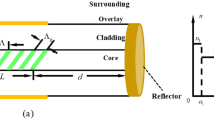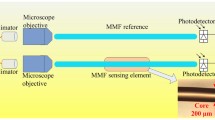Abstract
We proposed an ultra-high sensitivity triple-core fiber refractive index (RI) sensor with a modified Vernier effect for marine RI measurement and demonstrated it by numerical simulation. This sensor composes a pair of parallelized spatial mode Mach-Zehnder interferometers (MZIs), both of which are involved in sensing, but possess different interfering modes. By designing an MZI RI fiber optic sensor based on Vernier effect in air, it is demonstrated that in the low RI such as air environment, only the modes involved in sensing interference are affected by the environment to generate Vernier effect. In the high RI marine environment, both sensing interferometer and reference interferometer need to be affected by the ambient RI to generate Vernier effect. The simulation results indicate that the proposed novel sensing structure can amplify its sensitivity from −15 428 nm/RIU to −24 857 nm/RIU in the marine environment.
Similar content being viewed by others
References
CHAI F, JOHNSON K S, CLAUSTRE H, et al. Monitoring ocean biogeochemistry with autonomous platforms[J]. Nature reviews earth & environment, 2020, 1(6): 315–326.
RAHMSTORF S. Ocean circulation and climate during the past 120,000 years[J]. Nature, 2002, 419(6903): 207–214.
HURD C L, LAW C S, BACH L T, et al. Forensic carbon accounting: Assessing the role of seaweeds for carbon sequestration[J]. Journal of phycology, 2022, 58(3): 347–363.
BAUER J E, CAI W J, RAYMOND P A, et al. The changing carbon cycle of the coastal ocean[J]. Nature, 2013, 504(7478): 61–70.
FRANCIS J A, VAVRUS S J. Evidence for a wavier jet stream in response to rapid Arctic warming[J]. Environmental research letters, 2015, 10(1): 014005.
MORA C, SPIRANDELLI D, FRANKLIN E C, et al. Broad threat to humanity from cumulative climate hazards intensified by greenhouse gas emissions[J]. Nature climate change, 2018, 8(12): 1062.
SOLOMON S, PLATTNER G K, KNUTTI R, et al. Irreversible climate change due to carbon dioxide emissions[J]. Proceedings of the National Academy of Sciences of the United States of America, 2009, 106(6): 1704–1709.
HOEGH-GULDBERG O, MUMBY P J, HOOTEN A J, et al. Coral reefs under rapid climate change and ocean acidification[J]. Science, 2007, 318(5857): 1737–1742.
ORR J C, FABRY V J, AUMONT O, et al. Anthropogenic ocean acidification over the twenty-first century and its impact on calcifying organisms[J]. Nature, 2005, 437(7059): 681–686.
POERTNER H O, FARRELL A P. Ecology physiology and climate change[J]. Science, 2008, 322(5902): 690–692.
WANG C, ZHAO J, XING B. Environmental source, fate, and toxicity of microplastics[J]. Journal of hazardous materials, 2021, 407: 124357.
JIN P, ZHANG J, WAN J, et al. The combined effects of ocean acidification and heavy metals on marine organisms: a meta-analysis[J]. Frontiers in marine science, 2021, 8: 801889.
LEE M S, PARK K A, MICHELI F. Derivation of red tide index and density using geostationary ocean color imager (GOCI) data[J]. Remote sensing, 2021, 13(298): 1–18.
MIN R, LIU Z, PEREIRA L, et al. Optical fiber sensing for marine environment and marine structural health monitoring: a review[J]. Optics & laser technology, 2021, 140(6903): 107082.
QIAN J K, LV R Q, WANG S N, et al. High-sensitivity temperature sensor based on single-mode fiber for temperature-measurement application in the ocean[J]. Optical engineering, 2018, 57(10): 1.
CHEN W H, DILLON W D N, ARMSTRONG E A, et al. Self-referencing optical fiber pH sensor for marine microenvironments[J]. Talanta, 2021, 225: 121969.
LIU Z Y, ZHANG S Q, YANG C K, et al. Submarine optical fiber sensing system for the real-time monitoring of depth, vibration, and temperature[J]. Frontiers in marine science, 2022, 9: 922669.
CHEN Y, ZHAO L, HAO S, et al. Advanced fiber sensors based on the Vernier effect[J]. Sensors (Basel), 2022, 22(7).
GOMES A D, BARTELT H, FRAZÃO O. Optical Vernier effect: recent advances and developments[J]. Laser & photonics reviews, 2021, 15(7).
ZHAO Y, TONG R J, CHEN M Q, et al. Relative humidity sensor based on Vernier effect with GQDs-PVA un-fully filled in hollow core fiber[J]. Sensors and actuators A: physical, 2019, 285: 329–337.
LU C, DONG X, LU L, et al. Label free all-fiber static pressure sensor based on Vernier effect with temperature compensation[J]. IEEE sensors journal, 2020, 20(9): 4726–4231.
HUANG B, SHENG X, TANG Z, et al. High and online tunable sensitivity fiber temperature sensor based on Vernier-effect[J]. Optical fiber technology, 2022, 72.
WANG S, LIU T, WANG X, et al. Hybrid structure Mach-Zehnder interferometer based on silica and fluorinated polyimide microfibers for temperature or salinity sensing in seawater[J]. Measurement, 2019, 135: 527–536.
HONGKUN Z, YONG Z, QIANG Z, et al. High sensitivity optical fiber pressure sensor based on thin-walled oval cylinder[J]. Sensors and actuators A: physical, 2020, 310: 112042.
QIAN J, LV R, WANG S, et al. High-sensitivity temperature sensor based on single-mode fiber for temperature-measurement application in the ocean[J]. Optical engineering, 2018, 57(10): 107101.
Author information
Authors and Affiliations
Corresponding author
Ethics declarations
Conflicts of interest
The authors declare no conflict of interest.
Additional information
This work has been supported by the National Natural Science Foundation of China (Nos.11774181, 62231005, 62275131 and 62105164), the Natural Science Foundation of Tianjin (Nos.19JCYBJC16700, 20JCQNJC01480, 21JCQNJC00210 and 21JCYBJC00080), the Tianjin Graduate Research Innovation Project (No.2022BKY006), the Tianjin Development Program for Innovation and Entrepreneurship and the Fundamental Research Funds for the Central Universities, Nankai University.
Rights and permissions
About this article
Cite this article
Xiong, L., Yu, Y., Duan, S. et al. Simulations of ultra-high sensitivity RI sensor in triple-core fiber with modified Vernier effect: Application in marine RI measurement. Optoelectron. Lett. 19, 481–486 (2023). https://doi.org/10.1007/s11801-023-3020-2
Received:
Revised:
Published:
Issue Date:
DOI: https://doi.org/10.1007/s11801-023-3020-2




